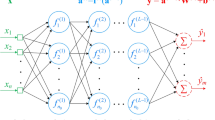Abstract
This paper investigates a new method to solve the inverse problem of Rutherford backscattering (RBS) data. The inverse problem is to determine the sample structure information from measured spectra, which can be defined as a function approximation problem. We propose using radial basis function (RBF) neural networks to approximate an inverse function. Each RBS spectrum, which may contain up to 128 data points, is compressed by the principal component analysis, so that the dimensionality of input data and complexity of the network are reduced significantly. Our theoretical consideration is tested by numerical experiments with the example of the SiGe thin film sample and corresponding backscattering spectra. A comparison of the RBF method with multilayer perceptrons reveals that the former has better performance in extracting structural information from spectra. Furthermore, the proposed method can handle redundancies properly, which are caused by the constraint of output variables. This study is the first method based on RBF to deal with the inverse RBS data analysis problem.





Similar content being viewed by others
Abbreviations
- RBF:
-
Radial basis function
- RBS:
-
Rutherford backscattering
References
Vizkelethy G (1994) Computer simulation of ion beam methods in analysis of thin films. Nucl Instr Methods B 89:122–130
Kótai E (1994) Computer methods for analysis and simulation of RBS and ERDA spectra. Nucl Instr Methods B 85:588–596
Toussaint Uv, Fischer R, Krieger K, Dose V (1999) Depth profile determination with confidence intervals from Rutherford backscattering data. New J Phys 1:11. doi:10.1088/1367-2630/1/1/311
Barradas NP, Jeynes C, Webb RP (1997) Simulated annealing analysis of Rutherford backscattering data. Appl Phys Lett 71:291–293
Bohr HG, Frimand K, Jalkanen KJ, Nieminen RM, Suhai S (2001) Neural-network analysis of the vibrational spectra of N-acetyl L-alanyl N-methyl amide conformational states. Phys Rev E 64:21905–21913
Barradas NP, Vieira A (2000) Artificial neural network algorithm for analysis of Rutherford backscattering data. Phys Rev E 62(4):5818–5829
Vieira A, Barradas NP (2001) Composition of NiTaC films on Si using neural networks analysis of elastic backscattering data. Nucl Instr Methods B 174:367–372
Hartman EJ, Keeler JD, Kowalski JM (1990) Layered neural networks with Gaussian hidden units as universal approximations. Neural Comput 2:210–215
Park J, Sandberg IW (1991) Universal approximation using radial basis function networks. Neural Comput 3:246–257
Poggio T, Girosi F (1990) Networks for approximation and learning. Proc IEEE 78:1481–1497
Er MJ, Chen W, Wu S (2005) High-speed face recognition based on discrete cosine transform and RBF neural networks. IEEE Trans Neural Netw 16(3):679–691
Mulgrew B (1996) Applying radial basis functions. IEEE Signal Process Mag 13:50–65
Inoue K, Iiguni Y, Maeda H (2003) Image restoration using the RBF network with variable regularization parameters. Neurocomputing 50:177–191
Narendra KG, Sood VK, Khorasani K, Patel R (1998) Application of a RBF neural network for fault diagnosis in a HVDC system. IEEE Trans Power Syst 13(1):177–183
Finan RA, Sapeluk AT, Damper RI (1996) Comparison of multilayer and radial basis function neural networks for text-dependent speaker recognition. In: International joint conference on neural networks (IJCNN’96), vol 4. San Diego, CA, pp 1992–1997
Whitehead BA, Choate TD (1996) Cooperative-competitive genetic evolution of radial basis function centers and widths for time series prediction. IEEE Trans Neural Netw 7:869–880
Howell AJ, Buxton H (1998) Learning identity with radial basis function networks. Neurocomputing 20:15–34
Chu W-K, Mayer JW, Nicolet M-A (1978) Backscattering spectrometry. Academic, New York
Broomhead DS, Lowe D (1988) Multivariable functional interpolation and adaptive networks. Complex Syst 2:321–355
Moody J, Darken CJ (1989) Fast learning in networks of locally-tuned processing units. Neural Comput 1:281–294
Duda RO, Hart PE (1973) Pattern classification and scene analysis. Wiley, New York
Breiman L, Friedman J, Olshen R, Stone C (1984) Classification and regression trees. Chapman and Hall, New York
Dempster AP, Laird NM, Rubin DB (1977) Maximum likelihood from incomplete data via the EM algorithm. J Roy Stat Soc B 39:1–38
Haykin S (1999) Neural networks: a comprehensive foundation, 2nd edn. Prentice-Hall, Upper Saddle River
Mayer M (2002) SIMNRA User’s Guide. Max-Planck Institute of Plasma Physics, Garching, Germany
Jolliffe IT (1986) Principal component analysis. Springer, New York
Nabney I (2002) Netlab: algorithms for pattern recognition, advances in pattern recognition. Springer, London
Nabney I, Bishop CM (2007) Netlab neural networks software. http://www.ncrg.aston.ac.uk/netlab/index.html
Li M, Fan X, Tickle K (2006) Principal component analysis and neural networks for analysis of complex spectral data from ion backscattering. In: Proceedings of the 2006 international conference on artificial intelligence and applications (AIA2006), Innsbruck, Austria, pp 228–234
Acknowledgments
The author (Michael M. Li) would like to acknowledge the financial support of this work from a Research Grant of the Faculty of Business and Informatics, Central Queensland University, Australia. The authors would also like to thank the anonymous reviewers for their valuable comments and advice.
Author information
Authors and Affiliations
Corresponding author
Rights and permissions
About this article
Cite this article
Li, M.M., Verma, B., Fan, X. et al. RBF neural networks for solving the inverse problem of backscattering spectra. Neural Comput & Applic 17, 391–397 (2008). https://doi.org/10.1007/s00521-007-0138-2
Received:
Accepted:
Published:
Issue Date:
DOI: https://doi.org/10.1007/s00521-007-0138-2




